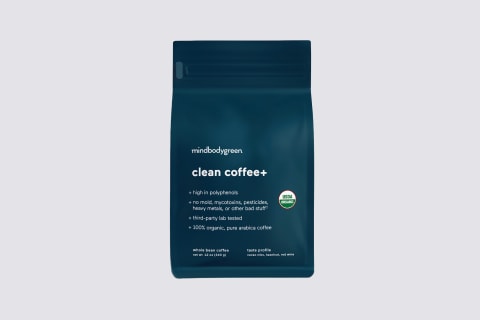Advertisement
3 Reasons Your At-Home Lattes Are Subpar & What To Do Instead


Sometimes, a $10 coffee from a café just seems to taste a million times better than something you'd make in your own kitchen. Well, as a trained barista who once worked at a common coffee chain, I know what goes into those luxe cups. Here are three reasons your lattes may be lacking and how to level up your at-home coffee game:
You aren't using high-quality coffee beans
A good latte starts with high-quality beans. It's easy to assume you can skip this part and that coffee is coffee, but that's unfortunately not the case when it comes to flavor.
If you want that aromatic effect, you'll need fresh, organic beans to get you there. Look for a clear roast date and certified organic label on the bag, and spend some time searching for a blend that meets your flavor preferences.
Similar to perfume, many premier coffee brands list out the flavor notes on their label. The mindbodygreen clean coffee+ blend is one worthy pick: It has a sweet and smooth taste with a balanced array of flavor notes including hazelnut, red wine, and chocolate.
Other beans may have hints of vanilla, cherry, almond, or other natural enhancements. Find one that speaks to you—that's the first step.
You're pre-grinding your beans
One of the sounds you may hear in a coffee shop is a loud buzzing noise: That's the bean grinder. Baristas grind their beans right before pulling an espresso shot since keeping beans whole until you are going to use them is a great way to preserve freshness and flavor. Sure, it takes an extra step when crafting your latte, but it's worth it to elevate the flavor and extend the shelf life of your beans (especially if you're investing good money in them).
You're not frothing your milk enough
Café-bought lattes often have a fluffy texture that can feel impossible to mimic at home. One reason you just can't seem to mirror the mouthfeel could be due to impatience.
It might feel like forever in the moment, but you should be frothing your milk for 20 to 45 seconds or until you reach a consistency that you enjoy. Oftentimes, at-home lattes get about two or three seconds of frothing and that's it, preventing the milk from becoming anything but stirred.
So whether you're working with a hand frother or something more established, give your milk time to reach its peak texture before throwing in the towel—especially if you're working with a thin liquid like almond milk.
As a final note, give yourself some grace if you're just starting out. Many baristas have to spend days, even weeks training until they master the art of a wonderful latte. As with any kitchen craft, it's all about practice—so, cheers to more lattes from here on out.
The takeaway
Three habits preventing you from crafting a grade-A latte include ignoring bean quality, pre-grinding your beans, and skipping the full froth period. If you want to learn more about the full-body benefits of drinking coffee daily (and yes, there are plenty), check out this guide.
